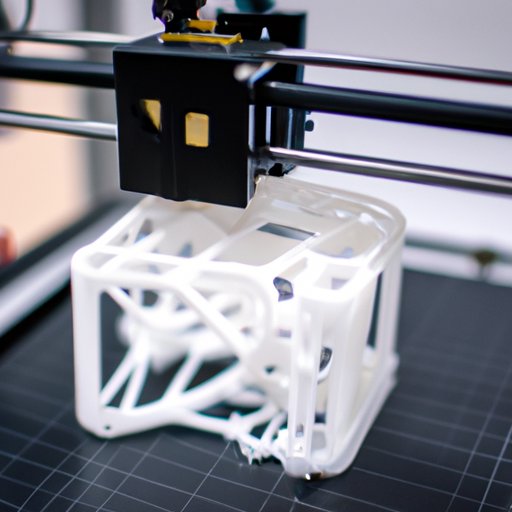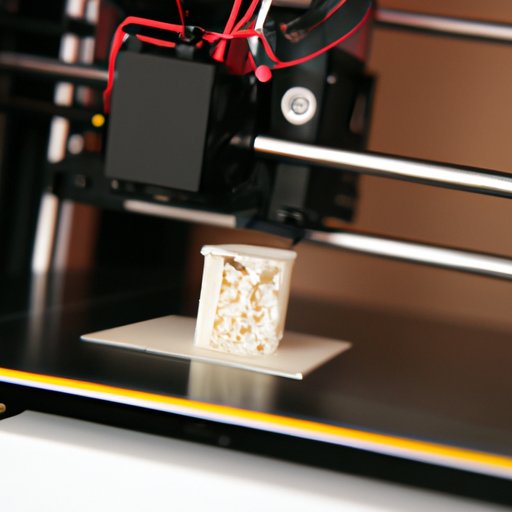Introduction
3D printing is a revolutionary technology that has been gaining popularity over the last few years. It is becoming increasingly accessible to businesses and individuals, allowing them to create complex structures quickly and cost-effectively. This article will explore how a 3D printer works and the various types of 3D printing available.
Overview of 3D Printing
3D printing is the process of creating three-dimensional objects from a digital file. The printer uses a variety of materials such as plastics, metals, and composites to build the object layer by layer. This allows for detailed and complex designs that would be difficult or impossible to create with traditional manufacturing methods.
Purpose of the Article
The purpose of this article is to provide an overview of 3D printing and explore the mechanics behind this technology. We will look at the different types of 3D printing and their benefits for businesses. We will also provide a step-by-step guide to understanding how a 3D printer works.

Exploring the Mechanics Behind 3D Printing
3D printing is an exciting technology that is being used in a wide range of industries. To understand how it works, it is important to first look at the basics of 3D printing.
The Basics of 3D Printing
3D printing starts with a digital 3D model created using computer-aided design (CAD) software. Once the model is complete, it can be sent to the 3D printer for production. The printer then builds the object layer by layer using a variety of materials.
Materials Used
The type of material used in 3D printing depends on the application and the desired outcome. Common materials include plastics, metals, composites, and ceramics. Each type of material has different properties and advantages, so it is important to choose the right material for the job.
Models Created
Once the model is complete, it can be printed in a variety of sizes and shapes. Some of the most common applications of 3D printing include prototype development, product design, and manufacturing. 3D printing is also being used to create medical devices, automotive parts, and even food products.
Step-by-Step Guide to 3D Printing Technology
Now that we have an understanding of the basics of 3D printing, let’s take a look at how it works. The following steps are involved in the 3D printing process:
- Design: The first step is to create a 3D model using CAD software.
- Preparation: The 3D model is then prepared for printing by slicing it into thin layers.
- Printing: The 3D printer then prints the object layer by layer using the specified material.
- Finishing: The printed object is then finished by sanding, polishing, or coating it with a protective layer.
Different Types of 3D Printing
Now that we have explored the mechanics behind 3D printing, let’s look at the different types of 3D printing available. Each type of 3D printing has its own unique advantages and disadvantages.
What They Do
The two most common types of 3D printing are Fused Deposition Modeling (FDM) and Selective Laser Sintering (SLS). FDM printers use a filament to build up layers of plastic, while SLS printers use lasers to fuse powdered materials together. Both types of printers can produce high-quality results, but they have different applications.
Benefits for Businesses
3D printing offers a number of benefits for businesses, including faster production times, lower costs, and greater design flexibility. According to a study by Deloitte, “3D printing has the potential to revolutionize the way companies design and manufacture products, enabling them to move away from mass production and towards personalized products.”
Conclusion
In conclusion, 3D printing is an exciting technology that is revolutionizing the way businesses design and manufacture products. It offers numerous benefits, including faster production times, lower costs, and greater design flexibility. This article has provided an overview of 3D printing and explored the mechanics behind this technology.
Summary of Key Points
3D printing is a revolutionary technology that is becoming increasingly accessible to businesses and individuals. It uses a variety of materials to build objects layer by layer, allowing for detailed and complex designs. There are two main types of 3D printing: FDM and SLS. These technologies offer a number of benefits, including faster production times, lower costs, and greater design flexibility.
Final Thoughts
3D printing is an exciting technology that is transforming the way businesses design and manufacture products. With its increasing accessibility, it is becoming easier than ever for businesses to take advantage of this technology. It is clear that 3D printing is here to stay and will continue to revolutionize the way we make things.
(Note: Is this article not meeting your expectations? Do you have knowledge or insights to share? Unlock new opportunities and expand your reach by joining our authors team. Click Registration to join us and share your expertise with our readers.)
